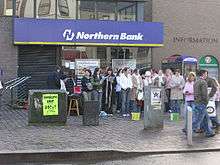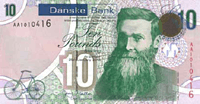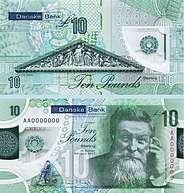Danske Bank (Northern Ireland)
Danske Bank UK (formerly Northern Bank) is a commercial bank in Northern Ireland. Northern Bank was one of the oldest banks in Ireland having been formed in 1809, and formed part of one of the Big Four banks in Ireland.[1] Northern Bank took on the name of its parent company Danske Bank as its trading name in November 2012.[2] The bank is considered one of the leading retail banks in Northern Ireland with 44 branches and 3 finance centres.[3] Danske Bank is one of the four commercial banks in Northern Ireland which are permitted to issue their own banknotes.
The Danske Bank logo | |
Northern Bank headquarters in Belfast, prior to the Danske Bank rebrand | |
| Danske Bank UK | |
| Private limited company | |
| Industry | Financial services |
| Founded | Belfast, Ireland (1824) |
| Headquarters | Belfast, Northern Ireland |
Area served | United Kingdom(previously also served Republic of Ireland) |
Key people | Gerald Gregory (Chairman) Kevin Kingston (CEO) |
| Products | Commercial Banking |
| Parent | Danske Bank A/S |
| Website | danskebank |
Danske Bank UK is a standalone business unit within the Danske Bank Group and operates under a UK banking licence.
History
_(cropped).jpg)
Northern Bank was founded in Belfast in 1809 as the Northern Banking Partnership. The bank expanded across Ireland, opening its first branch in the south in 1840.[4]
In 1965, the Northern Banking Company Limited was acquired by the Midland Bank, a London-based bank which had acquired the Belfast Bank in 1917. In 1970, the Midland's two Northern Ireland subsidiaries were merged to form Northern Bank Limited.[5] Under Midland's ownership, Northern Bank shared its parent company's branding and the Griffin logo.
In 1986, Midland re-organised its British and Irish operations, and as part of this process it separated its Northern Bank branches in the Republic of Ireland and transferred into a newly formed company called Northern Bank (Ireland) Limited.[5]
Acquisition by National Australia Bank

Midland Bank ran into severe financial difficulty as a result of its 1981 acquisition of Crocker National Bank in the US and was forced to divest itself of assets to restore stability. In 1988, Midland sold off its subsidiaries, namely the Clydesdale Bank in Scotland, Northern Bank Limited and Northern Bank (Ireland) Limited, all of which were acquired by National Australia Bank. After this, Northern Bank (Ireland) Limited was renamed National Irish Bank.[6][5] The Northern Bank brand name continued in Northern Ireland, but a new logo was introduced, a stylised "N" in a hexagon shape. In 2002, the bank's logotype (the word "Northern") was changed to match that of the National Australia Bank.
Acquisition by Danske Bank
In December 2004, the Denmark-based Danske Bank Group agreed to acquire Northern Bank and National Irish Bank for £967m. The sale of the two banks marked National Australia Bank's exit from the Irish banking markets.[7] Don Price remained as CEO, but was later replaced by Gerry Mallon in June 2008. The acquisition was completed in 2005 and Danske Bank invested approximately £100m in Northern Bank.[8] As part of this process, National Irish Bank was separated from the Northern Bank and given its own dedicated management team. Both Northern & National Irish Bank also migrated over to Danske Bank's technology platform with a centralised contact centre set up to deal with all incoming calls to the branches of both banks. From April 2006 the two banks also adopted new corporate identities which were based on a variation of the Danske Bank logo.
On 1 June 2012, brand separation between Northern Bank and National Irish Bank was also reversed, with the two banks merged under the Northern Bank management team.[9] On 19 November 2012 the bank formally dropped its Northern Bank name and began trading as Danske Bank. The first Danish branding was unveiled with new signage at the company's head office in Donegall Square.[2] Since the rebrand, cheques issued by the bank bear the legend "Danske Bank is a trading name of Northern Bank Limited". Danske Bank continues to issue pound sterling banknotes in Northern Ireland, and notes issued since 2013 now bear the Danske Bank brand name.[10]
In 2008, Northern Bank embarked on a £3m investment programme to upgrade facilities at three of its Northern Ireland branches.[11]
Organisational structure and leadership
As of November 2015, Kevin Kingston is the CEO of Danske Bank UK. The bank is organised into two business divisions.
Shaun McAnee is Managing Director of Corporate & Business Banking with responsibility for corporate banking, business banking, FX markets, specialist business, agri-business, small business and business acquisition. Aisling Press is Managing Director of Personal Banking incorporating branches, mortgage business, private banking and customer contact centres.
Stephen Matchett is the CFO and Vicky Davies, Managing Director of Strategy & Corporate Development.
Banknotes


In common with the other Big Four retail banks of Northern Ireland, Northern Bank trading as Danske Bank continues to issue its own banknotes, a practice which was abolished in England and Wales in the early Twentieth Century. Danske Bank notes are pound sterling notes and equal in value to Bank of England notes and should not be confused with banknotes of the former Irish pound, a separate currency which was replaced by the Euro in the Republic of Ireland in 2002; nor should Danske Bank notes be confused with banknotes of the Danish Krone issued by the Danish National Bank, in spite of the Danish name of the issuing bank.
Following the acquisition of Northern Bank by Danske Bank, banknotes issued since June 2013 now bear Danske Bank branding in place of the Northern Bank name; otherwise the designs remain identical to the previous issue. Older banknotes bearing the Northern Bank name are still in circulation and continue to be acceptable for payments as they are gradually withdrawn. Danske Bank has also ceased issue of £50 and £100 notes and will in future only print £10 and £20 notes.[12][13]
Danske Bank does not issue £5 notes, but a special commemorative £5 note was issued by the Northern Bank to mark the Year 2000. Uniquely among sterling notes, this was a vertical polymer banknote, printed by the Canadian Bank Note Company (CBN) on Australian synthetic polymer substrate instead of paper, making Northern Ireland the only part of the UK to have issued a plastic banknote prior to Scotland & England issuing the £5 polymer notes in Autumn 2016.[14][15] It is the only one of the bank's pre-2004 notes still in circulation; all others were recalled following the 2004 robbery.
As promissory notes, the current issue of the banknotes bear the inscription below the Danske Bank logo, "a trading name of Northern Bank Limited which promises to pay the bearer on demand", followed by the monetary value of the note.[13] Most Northern Bank banknotes feature an illustration on the reverse side of the portico of Belfast City Hall, sculpted by F. W. Pomeroy. The front of most notes depict a range of notable people associated with industry in Northern Ireland. The designs currently in circulation are:
| Denomination | Obverse illustration | Significance | Notes |
|---|---|---|---|
| £5 | US Space Shuttle | Northern Bank polymer note | |
| £10 | J. B. Dunlop | Inventor of the first pneumatic tyre in Belfast, 1887 | Reissued as Danske Bank note |
| £20 | Harry Ferguson | Inventor of the Ferguson P99 Formula One racing car, the Ferguson Tractor and the first Irish aviator | Reissued as Danske Bank note |
| £50 | Sir Samuel Cleland Davidson | Founder of the Belfast Sirocco Works and pioneer of air conditioning | Northern Bank note, to be withdrawn |
| £100 | Sir James Martin | Inventor of the aircraft ejector seat,[16] | Northern Bank note, to be withdrawn |
2005 reissue


Following the £26.5 million robbery in 2004 (see below), Northern Bank announced on 7 January 2005 that all its notes were to be recalled and reissued in revised designs and using an updated Northern Bank logo. The reissue began on 14 March 2005 and was scheduled to take one month; old notes remain exchangeable at branches of Northern Bank.[17] The principal colours of Northern Bank notes of greater than £5 face value were changed with the 2005 reissue, and are now as follows (former colour in brackets):
| Denomination | Pre-2005 | Post-2005 |
|---|---|---|
| £5 | green | unchanged |
| £10 | brown | green |
| £20 | purple | blue |
| £50 | green | purple |
| £100 | black | red |
On the older notes, the bank's N' symbol was enclosed in a vertical rectangular bar above the 'Northern' logo; after reissue, the N monogram was presented as a free-standing hexagonal graphic above the new italic Northern logo. After the Danske rebrand, Northern branding has been replaced with the Danske Bank logo on notes issued after 2013.
2019 polymer note
On 6 November 2018, Danske Bank announced the launch of a new polymer £10 banknote. The new note keeps the base design concept of the existing paper note but with subtle colour and feature upgrades - including a revised main portrait of inventor John Dunlop. In a change, the polymer note will also include an image of Mr Dunlop's son. The notes come into circulation on 27 February 2019.[18]
Robbery
On 20 December 2004 the cash centre at the bank's headquarters in Belfast was raided, and £26.5 million stolen. Most of this consisted of uncirculated Northern Bank notes, as well as millions in used notes. There was also over a million pounds in other currencies. The police and government as well as other major political figures in both Ireland and the United Kingdom accused the Provisional Irish Republican Army of being responsible.
On 9 October 2008 the trial of the only man to be charged with the robbery collapsed when Chris Ward, 26, was found not guilty.[19]
References
- "Banks in United Kingdom (UK or Britain)". ecbs.org. Retrieved 28 April 2013.
- "Hello Danske as a new era begins for Northern Bank" (Press release). Belfast: Danske Bank. 19 November 2012. Retrieved 29 November 2013.
- "Patronage – Danske Bank". Northern Ireland Chamber of Commerce. Archived from the original on 14 March 2013. Retrieved 2013-04-28.
- "History". Danske Bank. Retrieved 28 April 2013.
- Freitag, European Association for Banking History ; chief editor, Manfred Pohl ; assistant editor, Sabine (1994). Handbook on the history of European banks. Aldershot, Hants, England: E. Elgar. p. 1239. ISBN 9781781954218. Retrieved 28 June 2015.
- Fraser, Ian (2014). "3. Rebuilding the Royal". Shredded: Inside RBS: The Bank that Broke Britain. Birlinn. ISBN 9780857906236. Retrieved 28 June 2015.
- "Green light for NAB options desk". The Irish Independent. Retrieved 28 November 2013.
- O'Reilly, Gemma (10 December 2008). "Belfast paper leaves the Troubles behind". Brand Republic. Archived from the original on 18 January 2013. Retrieved 28 April 2013.
- "Danske Bank strengthens commitment to Northern Ireland". Danske Bank. 10 May 2012. Retrieved 28 April 2013.
- "Rebrand". Danske Bank. Retrieved 28 April 2013.
- "Northern Bank invests Pounds 3m to upgrade facilities". HighBeam Research. 24 November 2008. Archived from the original on 4 November 2012. Retrieved 28 April 2013.
- "Danske Bank puts new bank-notes into circulation". BBC News. Retrieved 27 November 2013.
- "Danske Bank Launch New Bank Notes". Belfast City Centre Management. 24 June 2013. Archived from the original on 3 December 2013. Retrieved 29 November 2013.
- "Moving to Polymer Banknotes". Retrieved 1 May 2017.
- "Polymer Scottish Banknotes". Retrieved 1 May 2017.
- "Irish Scientists and Inventors". Irish Patents Office. Retrieved 16 October 2008.
- "New Northern Bank notes unveiled". BBC News. 9 March 2005. Retrieved 30 November 2013.
- "Banks announce 'plastic' notes change". BBC News. 6 November 2018. Retrieved 8 January 2019.
- "£26m bank robbery trial collapses". BBC News. 9 October 2008. Retrieved 28 April 2013.
External links
| Wikimedia Commons has media related to Northern Bank. |
- Official website
- "Current Banknotes: Danske Bank". The Association of Commercial Banknote Issuers. Archived from the original on 28 October 2017. Retrieved 30 November 2013.